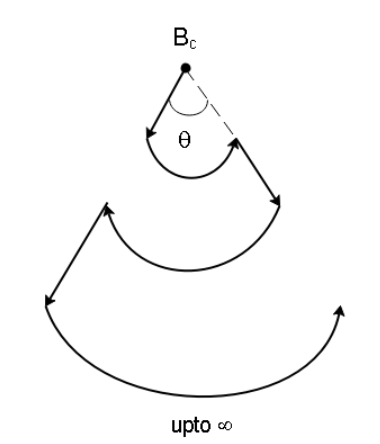Answer
35.4k+ views
Hint: In this solution, we will use the formula of the magnetic field generated by a current-carrying arc at its centre. Only the curved arcs will contribute to the magnetic fields since the straight bends are carrying a current in the direction of our point.
Formula used: In this solution, we will use the following formula:
Magnetic field due to curved arc: $B = \dfrac{{{\mu _0}I}}{{2a}}\dfrac{\theta }{{2\pi }}$ where$I$ is the current in the wire, $\theta $ is the angle subtended by the wire, $a$ is the radius of the wire.
Complete step by step answer:
In the diagram given to us, we can see that the wire is made up of curved portions and straight portions. Now, only the curved current-carrying portions will generate a magnetic field at the point of interest. This is because the straight wires are carrying current in a direction that passes through the point itself so there will be no magnetic field generated by the straight wire.
Now if the current in the first loop is $I$, the current in the next loop decreases by a factor $\eta $ so the current in the second loop will be $I/\eta $. Similarly, the current in the third loop will be $I/{\eta ^2}$, and so on.
Now the magnetic field due to one curved portion will be
$B = \dfrac{{{\mu _0}}}{{2a}}\dfrac{\theta }{{2\pi }}$
Since all the curves are at the same position (on top of each other), they will have the same radius, however, the current will be different. The current will also decrease in magnitude and the magnetic field generated by different loops will be different since the current flows in different directions.
Hence, the sum of all the individual magnetic fields will be
\[{B_{net}} = \dfrac{{{\mu _0}}}{{2r}}I\dfrac{\theta }{{2\pi }} - \dfrac{{{\mu _0}}}{{2a}}\dfrac{I}{\eta }\dfrac{\theta }{{2\pi }} + \dfrac{{{\mu _0}}}{{2a}}\dfrac{I}{{{\eta ^2}}}\dfrac{\theta }{{2\pi }} - \dfrac{{{\mu _0}}}{{2a}}\dfrac{I}{{{\eta ^3}}}\dfrac{\theta }{{2\pi }}....\]
Taking out $\dfrac{{{\mu _0}}}{{2a}}I\dfrac{\theta }{{2\pi }}$ common, we get
\[{B_{net}} = \dfrac{{{\mu _0}}}{{2a}}I\dfrac{\theta }{{2\pi }}\left( {1 - \dfrac{1}{\eta } + \dfrac{1}{{{\eta ^2}}} - \dfrac{1}{{{\eta ^3}}}...} \right)\]
The term in the bracket is an infinite geometric progression series so its sum will be $\dfrac{a}{{1 - m}}$ where $a = 1$ and $m = - \dfrac{1}{\eta }$. So,
\[{B_{net}} = \dfrac{{{\mu _0}}}{{2a}}I\dfrac{\theta }{{2\pi }}\left( {\dfrac{1}{{1 - \left( { - \dfrac{1}{\eta }} \right)}}} \right)\]
Or equivalently
\[{B_{net}} = \dfrac{{{\mu _0}}}{{4\pi a}}I\theta \left( {\dfrac{\eta }{{\eta + 1}}} \right)\]
Note: We must realize that the curved wires are not in-plane and are actually below each other. If the wires were in one plane, the radius of the curved regions would also eventually increase.
Formula used: In this solution, we will use the following formula:
Magnetic field due to curved arc: $B = \dfrac{{{\mu _0}I}}{{2a}}\dfrac{\theta }{{2\pi }}$ where$I$ is the current in the wire, $\theta $ is the angle subtended by the wire, $a$ is the radius of the wire.
Complete step by step answer:
In the diagram given to us, we can see that the wire is made up of curved portions and straight portions. Now, only the curved current-carrying portions will generate a magnetic field at the point of interest. This is because the straight wires are carrying current in a direction that passes through the point itself so there will be no magnetic field generated by the straight wire.
Now if the current in the first loop is $I$, the current in the next loop decreases by a factor $\eta $ so the current in the second loop will be $I/\eta $. Similarly, the current in the third loop will be $I/{\eta ^2}$, and so on.
Now the magnetic field due to one curved portion will be
$B = \dfrac{{{\mu _0}}}{{2a}}\dfrac{\theta }{{2\pi }}$
Since all the curves are at the same position (on top of each other), they will have the same radius, however, the current will be different. The current will also decrease in magnitude and the magnetic field generated by different loops will be different since the current flows in different directions.
Hence, the sum of all the individual magnetic fields will be
\[{B_{net}} = \dfrac{{{\mu _0}}}{{2r}}I\dfrac{\theta }{{2\pi }} - \dfrac{{{\mu _0}}}{{2a}}\dfrac{I}{\eta }\dfrac{\theta }{{2\pi }} + \dfrac{{{\mu _0}}}{{2a}}\dfrac{I}{{{\eta ^2}}}\dfrac{\theta }{{2\pi }} - \dfrac{{{\mu _0}}}{{2a}}\dfrac{I}{{{\eta ^3}}}\dfrac{\theta }{{2\pi }}....\]
Taking out $\dfrac{{{\mu _0}}}{{2a}}I\dfrac{\theta }{{2\pi }}$ common, we get
\[{B_{net}} = \dfrac{{{\mu _0}}}{{2a}}I\dfrac{\theta }{{2\pi }}\left( {1 - \dfrac{1}{\eta } + \dfrac{1}{{{\eta ^2}}} - \dfrac{1}{{{\eta ^3}}}...} \right)\]
The term in the bracket is an infinite geometric progression series so its sum will be $\dfrac{a}{{1 - m}}$ where $a = 1$ and $m = - \dfrac{1}{\eta }$. So,
\[{B_{net}} = \dfrac{{{\mu _0}}}{{2a}}I\dfrac{\theta }{{2\pi }}\left( {\dfrac{1}{{1 - \left( { - \dfrac{1}{\eta }} \right)}}} \right)\]
Or equivalently
\[{B_{net}} = \dfrac{{{\mu _0}}}{{4\pi a}}I\theta \left( {\dfrac{\eta }{{\eta + 1}}} \right)\]
Note: We must realize that the curved wires are not in-plane and are actually below each other. If the wires were in one plane, the radius of the curved regions would also eventually increase.
Recently Updated Pages
To get a maximum current in an external resistance class 1 physics JEE_Main

f a body travels with constant acceleration which of class 1 physics JEE_Main

A hollow sphere of mass M and radius R is rotating class 1 physics JEE_Main

If the beams of electrons and protons move parallel class 1 physics JEE_Main

Two radioactive nuclei P and Q in a given sample decay class 1 physics JEE_Main

If a wire of resistance R is stretched to double of class 12 physics JEE_Main

Other Pages
Oxidation state of S in H2S2O8 is A 6 B 7 C +8 D 0 class 12 chemistry JEE_Main

A closed organ pipe and an open organ pipe are tuned class 11 physics JEE_Main

Excluding stoppages the speed of a bus is 54 kmph and class 11 maths JEE_Main

The mole fraction of the solute in a 1 molal aqueous class 11 chemistry JEE_Main

Dissolving 120g of urea molwt60 in 1000g of water gave class 11 chemistry JEE_Main

Differentiate between homogeneous and heterogeneous class 12 chemistry JEE_Main




